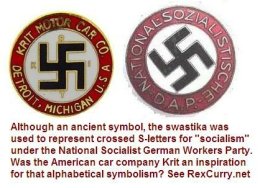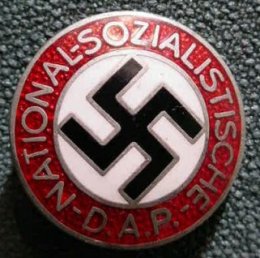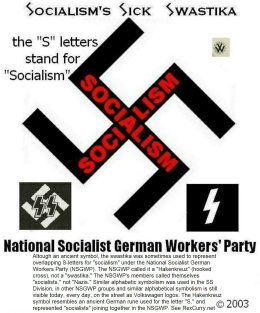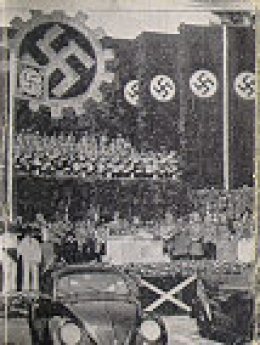If anyone can find out more about Kenneth Crittenden and any
explanantion he gave for the Krit logo, that would be very interesting
to read.
Another group had this information about the topic -
Krit Motor cars are part of the story of how Americans popularized
swastikas and nazi salutes worldwide.
Did nazis adopt the swastika and nazi salutes from American national
socialists?
The swastika was on American cars (e.g. the Krit Motor Car Company of
Detroit, Michigan from 1909 to 1915) years before it was associated
with German cars and the Volkswagen VW. http://rexcurry.net/krit_motor_car_company_detroit.html
Earlier, the use of the swastika by American national socialists began
with Edward Bellamy (in 1888 or before).
http://rexcurry.net/theosophy-madame-blavatsky-theosophical-society.html
Edward Bellamy was the cousin and cohort of Francis Bellamy, author of
the "Pledge of Allegiance" (PoA), the origin of the stiff-armed salute
in 1892. http://rexcurry.net/pledgetragedy.html
Did Krit and the Bellamys influence use of the swastika by the
National Socialist German Workers Party? Many Krit cars were exported
to Europe and Australia. On December 29, 1914, a New York Times
newspaper article states that WWI was responsible for the bankruptcy
of the Krit Motor Car Company, to wit: "Lack of business, due to the
European war, is given as the cause of the failure."
That means that an American car company was the first to put swastikas
on cars in Europe. Krit produced bus / truck models that could carry
15 people. Were Krit buses / trucks have been used in WWI by German
military, by the free corps (freikorps), or the Ehrhard Brigade? Did
Hitler see Krit cars or even ride in them?
Loading Image...
Here is a photograph of a Krit carrying 15 or more people.
Loading Image...
Edward Bellamy's book about national socialism, entitled "Looking
Backward" (1888), was an international bestseller translated into
every major language, including German. It inspired a national
socialism movement worldwide.
The Krit swastika had many similarities to the Hakenkreuz (hooked
cross) used later by German National Socialists. A photograph of the
Krit logo is at this link.
Loading Image...
The Krit swastika is very similar to the membership pin used under
Nazism.
Loading Image...
Here are other examples
Loading Image...
An important difference between the Krit swastika and the Nazi
membership pin's hakenkreuz is that the latter shows how the symbol
was turned 45 degrees from the horizontal to represent S-letters for
"sozialistische" (socialist) under the National Socialist German
Workers Party (NSGWP or NSDAP), as shown in the growing body of work
by the symbolist Dr. Rex Curry (author of "Swastika Secrets").
http://rexcurry.net/book1a1contents-swastika.html
Because of government schools (socialist schools) almost all Americans
are ignorant of the fact that the "nazis" did not call themselves
"nazis," nor "fascists," that it was not the "nazi party," and that
they did not call their symbol a "swastika." The use of the term
"nazi" rocketed (along with American ignorance) due to propaganda
after the USA became WWII allies with the former Union of Soviet
Socialist Republics (formerly a WWII ally of the National Socialist
German Workers Party).
Although an ancient symbol, the swastika was used to represent crossed
S-letters for "socialism" under the NSDAP. See the graphic image of
the swastika symbolism at
Loading Image...
Krit's swastika might have inspired the alphabetical symbolism under
Nazism, in that Krit's swastika examines alphabetical symbolism with
the four letters K-R-I-T spaced at the four sides of the flat
swastika. Adolf Hitler took the same idea another step.
The swastika as alphabetic symbolism in the USA was not new when
Hitler followed suit. The following link shows another example of the
swastika used as alphabetical symbolism in the USA.
http://rexcurry.net/swastika-hakenkreuz.html
The Volkswagen VW logo and the Audi logo expose the swastika as
intertwined "S" shapes symbolizing "Socialism" for the monstrous
National Socialist German Workers' Party, and provide more support for
Dr. Curry's work. http://rexcurry.net/bookchapter4a1a2a1.html
The following image shows additional graphic examples of the symbolism
of the swastika
Loading Image...
Before the VW emblem was created, the organization that controlled
volkswagen was the Deutsche Arbeitsfront (DAF or German Labor Front)
and its logo used a swastika encircled by a cogwheel.
Loading Image...
Similar alphabetical symbolism was used under the NSDAP for the "SS"
division, the "SA," the "NSV," et cetera.
Loading Image...
The Trabant car also provides support. http://rexcurry.net/trabant-sachsenring-rex-curry.html
The Krit company existed from July 1909 to 1915. The Krit car was
designed by Kenneth Crittenden, who had worked at Ford and Regal.
Although the swastika had a history as a generic "good luck" symbol,
that luck did not last for Krit, nor for the National Socialist German
Workers Party. However, the VW badge, based on the swastika
philosophically and stylistically, continues to be visible today and
every day on Volkswagen automobiles.
Not only did Woodrow Wilson's war (World War I) help bankrupt the Krit
company, so did Franklin Roosevelt's war (World War II). The mood
against German National Socialism spilled over against the remaining
6000 Krit cars originally built between 1909 and 1915 (due to the Krit
car's swastika symbol). Many of the remaining Krit cars were destroyed
for metal for WWII. Krit cars are very rare today.
New discoveries show that American soldiers used the swastika as their
symbol early in World War I, and up to 1941, against Germany. The
symbol was used by Americans in the French Escadrille Lafayette, by
the 45th Infantry Divison, and on Boeing P-12 planes.
http://rexcurry.net/45th-infantry-division-swastika-sooner-soldiers.html
Dr. Curry has previously shown how socialists in the USA originated
the modern swastika as overlapping "S" letters for "Socialists"
joining together in a utopian "Socialist Society" (decades later, it
was used by the National Socialist German Workers Party). During the
time when American soldiers adopted the swastika, the symbol was
associated in the USA with the growing popularity of "military
socialism," a dogma touted by Edward Bellamy, the American author of
the international bestseller "Looking Backward," (1887) known as the
bible of National Socialism. Edward Bellamy was cousin to Francis
Bellamy, author of the Pledge of Allegiance, the origin of the stiff-
armed salute adopted later by the NSGWP.
The symbol was also famous in the USA as alphabetical symbolism for
socialism in the Theosophical Society (TS), from 1875. The swastika
spread wide swathes of socialism via that group.
http://rexcurry.net/theosophy-madame-blavatsky-theosophical-society.html
In 1888, the Theosophical Society teamed up with the Bellamy
Nationalist movement for military socialism. The "Bellamy swastika"
and the "Bellamy salute" spread.
A Harvard grad, Ernst Hanfstaengl (aka "Hitler's Piano Player") is
another of many sources (including photographs and movies of the
Bellamy salute, and international travel) that exposed Hitler and
other German socialists to the early American stiff-armed salute and
the PoA's robotic chanting to flags in the USA. http://rexcurry.net/swastika-hanfstaengl.html
Dr. Curry's work has been cited and verified on Wikipedia. It might be
the most referenced historical research of its type on Wikipedia. His
work is sometimes used without attribution on Wikipedia in apparent
efforts to boost the credibility of the borrowers. Even Wikipedia's
founder Jimbo Wales has publicly commented on Dr. Curry's influence on
Wikipedia.